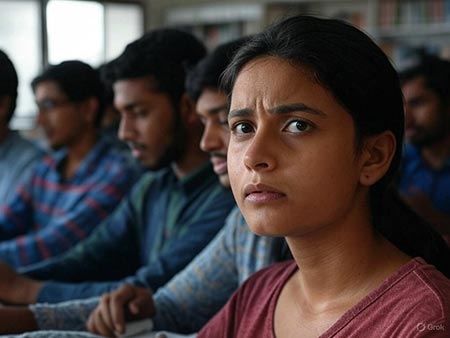India’s higher education system, one of the largest in the world with over 51,000 institutions and 37.6 million students, is grappling with a multifaceted crisis that threatens its ability to deliver quality education and prepare students for a rapidly evolving global economy. Recent discussions on social media platforms like X and various analyses highlight systemic issues, including leadership vacuums, administrative inefficiencies, declining quality, and inadequate funding, which collectively undermine the system’s effectiveness. This writeup explores the dimensions of this crisis and its implications, drawing on sentiments expressed in recent X posts and broader educational analyses.
Leadership and Administrative Failures
A significant concern raised on X is the lack of permanent leadership in premier institutions. Posts note that 17 top institutes, including Indian Institutes of Technology (IITs), Indian Institutes of Management (IIMs), and National Institutes of Technology (NITs), are operating under interim directors, with some vacancies persisting for over two years. This leadership vacuum disrupts strategic planning, delays decision-making, and erodes institutional accountability. For instance, the implementation of the National Testing Agency’s (NTA) Common University Entrance Test (CUET) in 2022-23 caused unprecedented admission delays, with PhD admissions at Jawaharlal Nehru University (JNU) completing only by mid-March 2023, eight months behind schedule. The multiple-choice format of CUET has also been criticized as inadequate for assessing diverse academic competencies, particularly for postgraduate and doctoral programs.
Declining Quality and Infrastructure
The quality of higher education in India is under strain due to insufficient funding, outdated curricula, and inadequate infrastructure. India spends approximately 3.1% of its GDP on education, far below the 6% recommended by every National Education Policy (NEP) since 1968. This underfunding results in outdated laboratories, understocked libraries, and inadequate campus facilities like dormitories and internet access. Faculty shortages exacerbate the issue, with over 30% of teaching positions vacant in 45 central universities. The student-faculty ratio in India’s best universities often exceeds 20:1, compared to 10:1 at leading global institutions, leaving professors overburdened and with little time for research or curriculum development. X posts lament the collapse of higher education, pointing to logistical failures in entrance exams, paper leaks, and a corrupt National Assessment and Accreditation Council (NAAC) rating system, where 20% of evaluators were reportedly fired due to irregularities.
Skill Mismatch and Employability
A critical dimension of the crisis is the disconnect between higher education and industry needs. Only 17.5% of India’s graduates are considered employable, reflecting a mismatch in skills, expectations, and demand. Curricula remain largely theoretical and outdated, failing to incorporate emerging technologies like artificial intelligence and machine learning. X users highlight the overemphasis on placements and jobs, which are scarce, while the academic environment stifles innovation and practical exposure. The NEP 2020 aims to increase the Gross Enrollment Ratio (GER) to 50% by 2035 from the current 27.2%, but achieving this goal requires massive investments—estimated at over Rs 1 lakh crore—and a overhaul of curricula to align with industry standards.
Impact of the COVID-19 Pandemic
The COVID-19 pandemic intensified existing deficiencies, particularly in access and mental health. The abrupt shift to online learning exposed disparities in digital infrastructure, with 78% of students citing high-speed internet costs as a barrier and 23.5% struggling with device sharing. Students from marginalized communities, including Scheduled Castes, Scheduled Tribes, and economically weaker sections, faced severe challenges, including discrimination and isolation, leading to increased stress and anxiety. A 2023 study noted that 50% of college students identified mental health as their primary source of stress, yet universities offer inadequate counseling services. The pandemic-induced learning gap and dissatisfaction with online education further eroded confidence in the system.
Privatization and Inequity
The growth of private universities, often with high fees and a focus on profit, has deepened inequities. X posts criticize the rise of private institutions with “crippling debt-inducing fees” as a norm, making quality education inaccessible to many. While public universities were envisioned to provide inclusive education, declining public funding—down to 1.2% of GDP for higher education—has shifted the burden to private players. This commercialization prioritizes privileged communities, leaving marginalized students reliant on underfunded public institutions. The lack of reservation policies in private universities further exacerbates social inequalities.
Proposed Solutions and the Way Forward
Addressing this crisis requires comprehensive reforms. Increasing public funding to 6% of GDP, as recommended by NEP, is critical to improving infrastructure and hiring qualified faculty. Industry-academia partnerships, such as mandatory faculty sabbaticals and industry-specific curriculum advisory boards, could bridge the skill gap. Digital initiatives like SWAYAM and the National Digital Library of India show promise but need robust implementation to ensure equitable access. Reforming the NTA’s examination processes to ensure fairness and transparency is essential, as is addressing corruption in accreditation systems like NAAC. Finally, prioritizing mental health support and fostering an entrepreneurial ecosystem within universities can empower students to navigate academic and career challenges.
Conclusion
India’s higher education system stands at a crossroads, facing an unprecedented crisis marked by leadership deficits, quality erosion, and systemic inequities. Sentiments on X reflect deep frustration with administrative failures and the declining state of institutions, echoing broader analyses of funding shortages and skill mismatches. Without urgent and sustained reforms, the system risks failing millions of young Indians, undermining the country’s economic and social progress. By prioritizing quality, inclusivity, and industry alignment, India can transform its higher education landscape to meet the demands of the 21st century.
